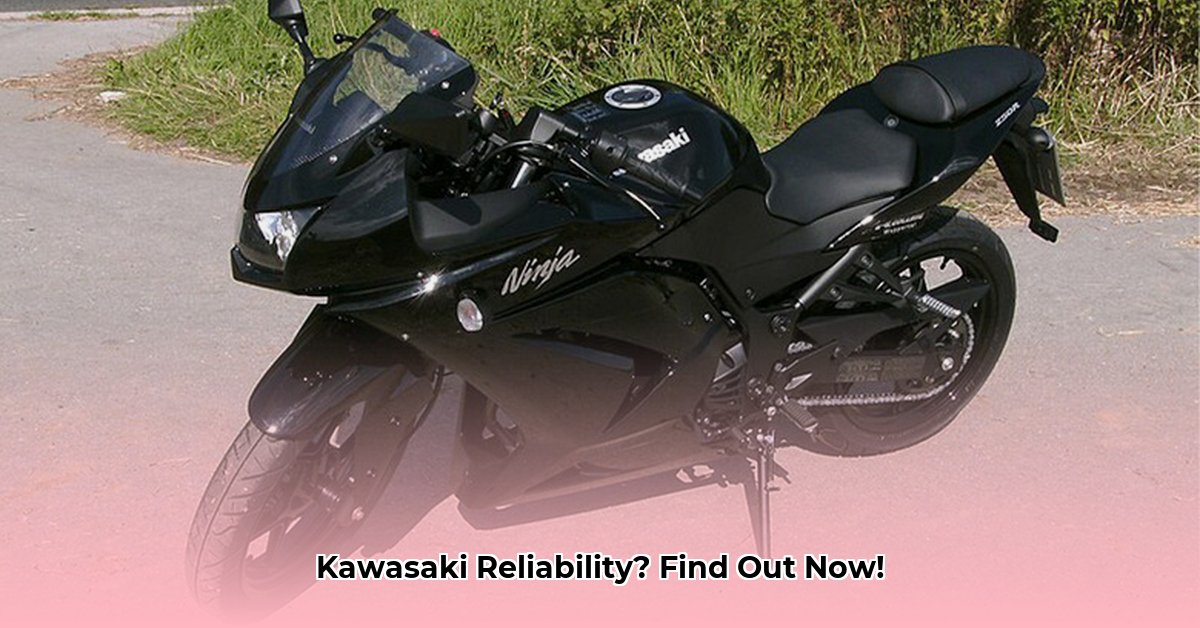
Thinking about purchasing a Kawasaki motorcycle? Reliability is a top concern for any buyer. This comprehensive guide provides an objective assessment of Kawasaki motorcycle reliability, examining various models and offering practical maintenance advice to maximize your bike's lifespan.
Are Kawasaki Motorcycles Reliable? A Data-Driven Look
The simple answer is: generally, yes. Kawasaki boasts a strong reputation for building durable motorcycles with a history of longevity. However, like any machine, consistent maintenance is critical for optimal performance and extended lifespan. This analysis delves into specific models and common issues, providing a nuanced perspective on Kawasaki's reliability.
Kawasaki Model Reliability: A Closer Examination
Several Kawasaki models stand out for their reliability. The Ninja 250, for example, is renowned for its durability and straightforward maintenance, making it a popular choice among riders of all experience levels. Similarly, the Ninja 650 receives high marks for reliability. Though some owners with extremely high mileage (over 100,000 miles) have reported fuel pump issues, this is not a widespread concern.
The powerful Z1000 also exhibits generally good reliability, although some owners have noted cosmetic exhaust discoloration over time. Models such as the Versys 650 and Vulcan 900 also consistently perform well in owner surveys. This consistent positive feedback across a diverse range of models underscores Kawasaki's commitment to manufacturing quality motorcycles.
Factors Affecting Kawasaki Motorcycle Reliability
Several interconnected factors determine a Kawasaki motorcycle's reliability:
Robust Construction: Kawasaki's manufacturing processes prioritize building strong machines, minimizing defects and promoting long-term durability.
Design Features: Many Kawasaki models feature practical designs that simplify maintenance. Easy access to components reduces repair time and cost.
Owner Maintenance: Regular maintenance is paramount. Neglecting routine servicing will inevitably lead to problems regardless of the bike's inherent build quality.
Common Issues and Proactive Solutions
While generally reliable, some minor issues have been reported in certain Kawasaki models:
| Model | Common Problem(s) | Prevention Strategies |
|---|---|---|
| Ninja 650 | Potential fuel pump failure at very high mileage | Regular fuel system inspections during routine maintenance |
| Z1000 | Exhaust pipe discoloration | Regular cleaning and maintenance |
| Various Models | Minor electrical issues, typical wear and tear | Prompt attention to any issues, diligent preventative maintenance |
It is crucial to emphasize that these aren't widespread, catastrophic failures. They are more likely to occur in older machines or with deferred maintenance. Regular servicing is the most effective prevention measure.
Is a Kawasaki Motorcycle Right for You?
The reliability of a Kawasaki motorcycle ultimately depends on individual rider habits and maintenance practices. However, considerable data points to generally reliable machines. Conduct thorough research on specific models of interest, exploring online reviews and owner forums to gauge individual experiences. The cost of regular maintenance should also be factored into the overall cost of ownership.
A well-maintained Kawasaki offers the potential for years of enjoyable riding. However, remember even the most durable machines require proper care and attention.
How to Maximize Your Kawasaki's Lifespan: A Maintenance Guide
Key Takeaways:
- Kawasaki motorcycles typically exhibit good reliability, often exceeding 100,000 miles with proper care.
- Reliability varies between models; thorough research before purchase is essential.
- Preventing rust is crucial for long-term durability.
- Adhering to the manufacturer's recommended maintenance schedule is key to extending the lifespan.
Proactive Maintenance for Long-Term Reliability
Regular maintenance is the cornerstone of extending the life of your Kawasaki motorcycle. Ignoring routine servicing will inevitably curtail your machine's lifespan. Following Kawasaki's recommended maintenance schedule is non-negotiable. This includes regular oil changes, filter replacements, and thorough inspections.
Preventing Rust: A Critical Step
Rust prevention is often overlooked but is crucial, particularly in humid or coastal climates. Regular cleaning and the application of rust inhibitors to vulnerable areas (frame, wheels, exhaust) will significantly extend your motorcycle's life. In coastal or particularly wet areas, even more proactive rust prevention is necessary.
A Practical Maintenance Plan: Step-by-Step Guide
Follow these steps for optimal Kawasaki motorcycle maintenance:
- Regular Oil Changes: Adhere strictly to the manufacturer's specified intervals and oil type.
- Filter Replacements: Replace air, oil, and fuel filters according to the manufacturer's schedule.
- Chain/Belt Maintenance: Regularly lubricate chains or inspect belts for wear and tear.
- Tire Pressure: Maintain correct tire pressure for optimal handling and tire longevity.
- Brake Inspections: Regularly inspect brake pads for wear and tear.
- Fluid Checks: Regularly check coolant, brake fluid, and clutch fluid levels.
- Visual Inspections: Conduct regular visual inspections for any damage or wear.
- Seasonal Storage: Employ proper storage techniques during off-season to prevent rust and damage.
- Professional Servicing: Schedule regular professional servicing to address any issues before they escalate.
Planning for Long-Term Care
As your Kawasaki accumulates miles, factor in the cost of replacing wear-and-tear items like brake pads, tires, chains (or belts). Setting aside a dedicated maintenance fund will help manage these costs effectively. While Kawasaki's are generally reliable, no machine is flawless. Diligent research, proactive maintenance, and careful planning are key to a long and satisfying ownership experience.